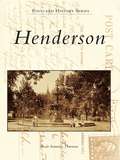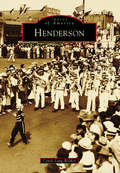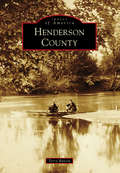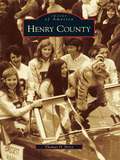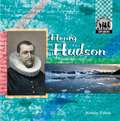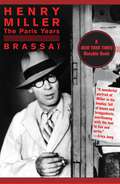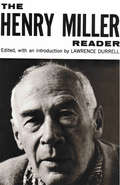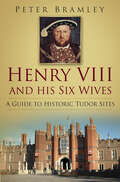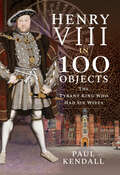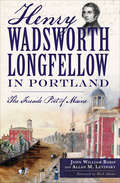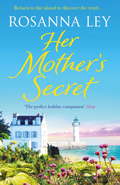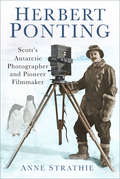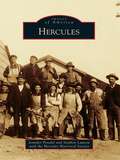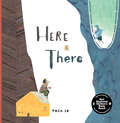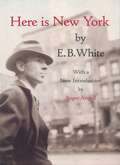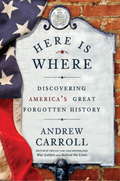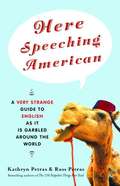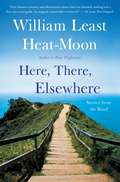- Table View
- List View
Henderson (Postcard History)
by Susan Sommers ThurmanThese vintage picture postcards take readers on a trip through the history of Henderson. Featured are the city's many remarkable parks, businesses, hotels, schools, and homes--some lost to time and some transported into the 21st century. The images and stories in this book will entertain and educate architecture buffs, rail fans, river enthusiasts, historians, and visitors and residents, past and present.
Henderson
by Cyndi Long WalkerOne of the oldest towns in Texas, Henderson--founded in 1843--is situated in the rolling green hills and pine forests of East Texas. Named for the state's first governor, James P. Henderson, the town is the seat of Rusk County. Henderson's fertile land and abundant stores of clay were enjoyed for centuries by Caddo Indians and other indigenous people; after settlement by Anglos, beginning in the 1830s, the area became known for cotton plantations. More Old South than Old West, Henderson might have had spectacular growth if the planned Galveston, Houston & Henderson Railroad had come to fruition. When that did not happen, Henderson relied on an economy based on cotton, farming, and logging until the Great East Texas Oilfield was discovered in 1930 just a few miles west. Oil, and later the commercial production of bricks, paved the way for a brighter future for the town, which today is still partially sustained by the riches of the earth through lignite production. Generations of hardworking men and women have called Henderson home, and the town today enjoys a revitalized town square filled with shops and restaurants.
Henry County
by Thomas D. PerryFormed in January 1777, Henry County was named for the Commonwealth of Virginia's first governor, Patrick Henry, who lived in the county from 1779 until 1784. Located along the border of North Carolina, the county was once home to the famous antebellum Hairston family. In the 20th century, textiles, furniture, and the chemical manufacturer DuPont made up the large industrial base of the county. With the recent outsourcing of jobs, the county has turned to other economic sources such as the Martinsville Speedway, Virginia Museum of Natural History, and the Bassett Historical Center, which provided most of the photographs in this book.
Henry Hudson
by Kristin PetrieThis biography introduces young readers to the life of Englishman Henry Hudson. Readers learn that Hudson's grandfather helped form the Muscovy Company and that Hudson himself later sailed for the Muscovy Company, trying to find a passage to Asia through the North Pole. Hudson's family life and work as a cabin boy are also discussed, as well as his voyage with John Davis to the Canadian Arctic. Through engaging text, readers learn that Hudson's goal was to find a shorter route from Europe to Asia through the Arctic Ocean. His attempts to find a northwest passage to Asia while working for the Dutch East India Company and the British East India Company are explained. Readers also discover that on his final voyage, Hudson was the victim of a mutiny and left to die in the Hudson Bay. The book explains that Hudson's discoveries led to Dutch and English colonization of North America and that today a strait, a bay, and a river are named after Hudson. The book also introduces the idea that Hudson's North American discoveries led other explorers to discover a Northwest Passage.
Henry Miller: The Paris Years
by Brassaï&“A wonderful portrait of Miller in his heyday: full of beans and braggadocio, overflowing with the lust to live and write.&”—Erica Jong His years in Paris were the making of Henry Miller. He arrived with no money, no fixed address, and no prospects. He left as the renowned if not notorious author of Tropic of Cancer and Tropic of Capricorn. Miller didn&’t just live in Paris—he devoured it. It was a world he shared with Brassaï, whose work, first collected in Paris by Night, established him as one of the greatest photographers of the twentieth century and the most exquisite and perceptive chronicler of Parisian vice. In Miller, Brassaï found his most compelling subject. Henry Miller: The Paris Years is an intimate account of a writer&’s self-discovery, seen through the unblinking eye of a master photographer. Brassaï delves into Miller&’s relationships with Anaïs Nin and Lawrence Durrell, as well as his hopelessly tangled though wildly inspiring marriage to June. He uncovers a side of the man scarcely known to the public, and through this careful portrait recreates a bright and swift-moving era. Most of all, Brassaï evokes their shared passion for the street life of the City of Light, captured in a dazzling moment of illumination.
The Henry Miller Reader (Essay Index Reprint Ser.)
by Henry Miller Lawrence DurrellA collection of works spanning the entire career of great 20th-century American writer Henry Miller, edited and introduced by Lawrence Durrell. In 1958, when Henry Miller was elected to membership in the American Institute of Arts and Letters, the citation described him as: "The veteran author of many books whose originality and richness of technique are matched by the variety and daring of his subject matter. His boldness of approach and intense curiosity concerning man and nature are unequalled in the prose literature of our times." It is most fitting that this anthology of "the best" of Henry Miller should have been assembled by one of the first among Miller’s contemporaries to recognize his genius, the eminent British writer Lawrence Durrell. Drawing material from a dozen different books Durrell has traced the main line and principal themes of the "single, endless autobiography" which is Henry Miller’s life work. "I suspect," writes Durrell in his Introduction, "that Miller’s final place will be among those towering anomalies of authorship like Whitman or Blake who have left us, not simply works of art, but a corpus of ideas which motivate and influence a whole cultural pattern." Earlier, H. L. Mencken had said, "his is one of the most beautiful prose styles today," and the late Sir Herbert Read had written that "what makes Miller distinctive among modern writers is his ability to combine, without confusion, the aesthetic and prophetic functions." Included are stories, "portraits" of persons and places, philosophical essays, and aphorisms. For each selection Miller himself prepared a brief commentary which fits the piece into its place in his life story. This framework is supplemented by a chronology from Miller’s birth in 1891 up to the spring of 1959, a bibliography, and, as an appendix, an open letter to the Supreme Court of Norway written in protest of the ban on Sexus, a part of which appears in this volume.
Henry VIII and His Six Wives: A Guide to Historic Tudor Sites
by Peter BramleyIn his hunt for a male heir Henry VIII broke with Rome, instigated the Reformation and the Dissolution of the Monasteries, and acquired six wives successively. Of these, two were executed, a chilling first in English history. From these tumultuous events a surprising number of historic sites linked to the Tudors survive, accessible now through this beautifully illustrated book. The guidebook is arranged by region and covers England and a little of Europe. With directions to each site, along with full details of the Tudor events and personalities linked to them, this guidebook will appeal to all who find visiting an historic site brings life and colour to the study of history.
Henry VIII in 100 Objects: The Tyrant King Who Had Six Wives (In 100 Objects Ser.)
by Paul Kendall“Full of excellent and pristine photographs of many items and places that shaped the life of one of England’s most fascinating kings . . . five stars.” —UK HistorianHenry VIII is one of history’s most memorable monarchs. Popularly known for his six wives, and the unfortunate fate which befell Anne Boleyn and Catherine Howard, Henry initiated many reforms and changes which still affect our lives today.In this engaging and hugely informative book, the author takes us on a journey across England, from Deal Castle on the south coast, to Tower Green where Anne Boleyn and Catherine Howard lost their heads, and far north to Rievaulx Abbey in Yorkshire. Along the way we see places where Henry stayed, where the Mary Rose, one of his great warships, was recovered, the homes of his consorts, and Smithfield where prominent individuals convicted of heresy were burned at the stake. Travel, then, not just across the country, but also back in time through 100 objects from the days of the second Tudor monarch—Henry VIII.“Because the items and places are so varied, the book has a wealth of information and the author has done a lot of research to present as much detail as possible . . . [a] really well-written and illustrated book about the people, places and objects that would have been familiar to Henry VIII.” —Tudor Blogger“Beautifully and profusely illustrated throughout . . . an extraordinarily informative and inherently fascinating introduction to the life and times of Henry VIII.” —Midwest Book Review
Henry Wadsworth Longfellow in Portland: The Fireside Poet of Maine
by John William Babin Allan M. LevinskyA look at the beloved American poet&’s home and family, and a glimpse at the early years of Portland, Maine. When a former Revolutionary War general named Peleg Wadsworth finished building a two-story brick house on Congress Street in 1786, the &“province of Maine&” was still considered part of Massachusetts, and he could see the Fore River from his front door. The city would grow up around the structure, as the Wadsworth-Longfellow family flourished and made history within its walls—and in the fabric of young America&’s culture and government. Peleg&’s daughter, Zilpah, married Stephen Longfellow IV on the first floor, and they raised their eight children in the home with love and high standards. Their second-eldest son, Henry Wadsworth Longfellow, wrote his first childhood poem there before going on to pen great classics including &“Paul Revere&’s Ride&” and Evangeline. Young Henry also watched his father help craft the Maine Constitution, and experienced revolutionary ideals of his home city. This book takes you inside the historic Longfellow House—and lets you explore the city that shaped a renowned American poet. Includes photos and illustrations
Her Husband's Mistake: Should she forgive him? The No. 1 Bestseller
by Sheila O'FlanaganTHE NO. 1 BESTSELLERSHEILA'S FANTASTIC NEW NOVEL 'THE WOMEN WHO RAN AWAY' IS OUT NOW - AND YOU CAN PRE-ORDER THE PAPERBACK NOW!The page-turning new novel about a marriage, a secret, and a wife's choice, from the bestselling author of The Missing Wife and The Hideaway'Brilliantly written and with plot twists popping out like Prosecco corks, this is a devour-over-a-weekend gem' Woman and Home'One of my favourite authors' Marian KeyesDave's made a BIG mistake. What's Roxy going to do about it? The riveting new novel from No. 1 bestselling author Sheila O'Flanagan. Perfect for readers of Marian Keyes and Amanda Prowse. Roxy's marriage has always been rock solid.After twenty years, and with two carefree kids, she and Dave are still the perfect couple.Until the day she comes home unexpectedly, and finds Dave in bed with their attractive, single neighbour.Suddenly Roxy isn't sure about anything - her past, the business she's taken over from her dad, or what her family's future might be. She's spent so long caring about everyone else that she's forgotten what she actually wants. But something has changed. And Roxy has a decision to make.Whether it's with Dave, or without him, it's time for Roxy to start living for herself...What readers are saying about HER HUSBAND'S MISTAKE: 'An emotional read ... I would happily recommend' 5 stars'Can't put it down' 5 stars'Satisfying, uplifting' 5 stars'A great read, really a feel-good book' 5 stars
Her Husband's Mistake: Should she forgive him? The No. 1 Bestseller
by Sheila O'FlanaganTHE NO. 1 BESTSELLERSHEILA'S FANTASTIC NEW NOVEL 'THE WOMEN WHO RAN AWAY' IS OUT NOW - AND YOU CAN PRE-ORDER THE PAPERBACK NOW!The page-turning new novel about a marriage, a secret, and a wife's choice, from the bestselling author of The Missing Wife and The Hideaway'Brilliantly written and with plot twists popping out like Prosecco corks, this is a devour-over-a-weekend gem' Woman and Home'One of my favourite authors' Marian KeyesDave's made a BIG mistake. What's Roxy going to do about it? The riveting new novel from No. 1 bestselling author Sheila O'Flanagan. Perfect for readers of Marian Keyes and Amanda Prowse. Roxy's marriage has always been rock solid.After twenty years, and with two carefree kids, she and Dave are still the perfect couple.Until the day she comes home unexpectedly, and finds Dave in bed with their attractive, single neighbour.Suddenly Roxy isn't sure about anything - her past, the business she's taken over from her dad, or what her family's future might be. She's spent so long caring about everyone else that she's forgotten what she actually wants. But something has changed. And Roxy has a decision to make.Whether it's with Dave, or without him, it's time for Roxy to start living for herself...What readers are saying about HER HUSBAND'S MISTAKE: 'An emotional read ... I would happily recommend' 5 stars'Can't put it down' 5 stars'Satisfying, uplifting' 5 stars'A great read, really a feel-good book' 5 stars
Her Husband's Mistake: Should she forgive him? The No. 1 Bestseller
by Sheila O'FlanaganShould a woman be ready to forgive and forget to save her marriage? Roxy's not so sure... The riveting new novel from No. 1 bestselling author Sheila O'Flanagan. Perfect for readers of Marian Keyes and Kerry Fisher. When Roxy comes home unexpectedly one day to give her husband Dave a lovely surprise, it's Roxy who gets shock of her life. And all she wants to do is run away. Roxy knows she has to face up to what's happened and decide: forgive and forget, or bring an end to a decade-long marriage. Surely the right thing is to get over it - that's what Dave thinks. After all, it's just one mistake... But Roxy finds it's not so simple. Especially when another secret starts to emerge. Her friends and family all know what they'd do - but they're not Roxy...'One of my favourite authors' Marian Keyes(P)2019 Headline Publishing Group Ltd
Her Mother's Secret: Escape to sunny France with the Number One bestselling author
by Rosanna Ley'A beautifully written story of loss and love, Her Mother's Secret is Rosanna Ley at her best' My WeeklyEscape to the heart of enchanting Brittany with the bestselling author of The Villa and The Little Theatre by the Sea. The perfect treat for fans of Santa Montefiore and Veronica Henry.For many years Colette has avoided returning to her homeland - the magical island of Belle-Île-en-Mer in Southern Brittany - afraid to confront the painful memories she left behind. She is living on the Cornish coast when she hears about her mother Thea's failing health and realises that the time has come for her to go home. But can Colette ever forgive Thea for what she has done? Despite Colette's wariness, romantic Belle-Île still fascinates her. She takes on the running of her mother's flower shop and makes friends with Élodie from the Old Lighthouse where Thea once worked as a nanny and with the enigmatic Étienne who shares Colette's mixed feelings about the island. As Thea opens up to her for the first time, Colette finds herself softening and being drawn back into the landscape of her past. But can Belle-Île also be a part of her future?The ghosts of that past still linger. What happened all those years ago and how did it cause the rift between mother and daughter? It becomes clear that the beauty of Belle-Île hides a devastating family secret - one that Colette is determined to unravel at any cost.
Her Mother's Secret: Escape to sunny France with this enchanting story of loss and love
by Rosanna Ley'A beautifully written story of loss and love, Her Mother's Secret is Rosanna Ley at her best' My WeeklyEscape to the heart of enchanting Brittany with the bestselling author of The Villa and The Little Theatre by the Sea. The perfect treat for fans of Santa Montefiore and Veronica Henry.For many years Colette has avoided returning to her homeland - the magical island of Belle-Île-en-Mer in Southern Brittany - afraid to confront the painful memories she left behind. She is living on the Cornish coast when she hears about her mother Thea's failing health and realises that the time has come for her to go home. But can Colette ever forgive Thea for what she has done? Despite Colette's wariness, romantic Belle-Île still fascinates her. She takes on the running of her mother's flower shop and makes friends with Élodie from the Old Lighthouse where Thea once worked as a nanny and with the enigmatic Étienne who shares Colette's mixed feelings about the island. As Thea opens up to her for the first time, Colette finds herself softening and being drawn back into the landscape of her past. But can Belle-Île also be a part of her future?The ghosts of that past still linger. What happened all those years ago and how did it cause the rift between mother and daughter? It becomes clear that the beauty of Belle-Île hides a devastating family secret - one that Colette is determined to unravel at any cost.
Her Mother's Secret: Escape to sunny France with this enchanting story of loss and love
by Rosanna Ley'A beautifully written story of loss and love, Her Mother's Secret is Rosanna Ley at her best' My WeeklyEscape to the heart of enchanting Brittany with the bestselling author of The Villa and The Little Theatre by the Sea. The perfect treat for fans of Santa Montefiore and Veronica Henry.For many years Colette has avoided returning to her homeland - the magical island of Belle-Île-en-Mer in Southern Brittany - afraid to confront the painful memories she left behind. She is living on the Cornish coast when she hears about her mother Thea's failing health and realises that the time has come for her to go home. But can Colette ever forgive Thea for what she has done? Despite Colette's wariness, romantic Belle-Île still fascinates her. She takes on the running of her mother's flower shop and makes friends with Élodie from the Old Lighthouse where Thea once worked as a nanny and with the enigmatic Étienne who shares Colette's mixed feelings about the island. As Thea opens up to her for the first time, Colette finds herself softening and being drawn back into the landscape of her past. But can Belle-Île also be a part of her future?The ghosts of that past still linger. What happened all those years ago and how did it cause the rift between mother and daughter? It becomes clear that the beauty of Belle-Île hides a devastating family secret - one that Colette is determined to unravel at any cost.
Her Mother's Secret: Escape to sunny France with the Number One bestselling author
by Rosanna LeyEscape to the heart of enchanting Brittany with the bestselling author of The Villa and The Little Theatre by the Sea. The perfect treat for fans of Santa Montefiore and Veronica Henry.For many years Colette has avoided returning to her homeland - the magical island of Belle-Île-en-Mer in Southern Brittany - afraid to confront the painful memories she left behind. She is living on the Cornish coast when she hears about her mother Thea's failing health and realises that the time has come for her to go home. But can Colette ever forgive Thea for what she has done? Despite Colette's wariness, romantic Belle-Île still fascinates her. She takes on the running of her mother's flower shop and makes friends with Élodie from the Old Lighthouse where Thea once worked as a nanny and with the enigmatic Étienne who shares Colette's mixed feelings about the island. As Thea opens up to her for the first time, Colette finds herself softening and being drawn back into the landscape of her past. But can Belle-Île also be a part of her future?The ghosts of that past still linger. What happened all those years ago and how did it cause the rift between mother and daughter? It becomes clear that the beauty of Belle-Île hides a devastating family secret - one that Colette is determined to unravel at any cost.
Her Mother's Secret: Escape to sunny France this summer with the number one bestselling author
by Rosanna Ley'A beautifully written story of loss and love, Her Mother's Secret is Rosanna Ley at her best' My Weekly'Sun-soaked escapism' Best'The ultimate feel-good read' CandisFor many years Colette has avoided returning to her homeland - the magical island of Belle-Île-en-Mer in Southern Brittany - afraid to confront the painful memories she left behind. She is living on the Cornish coast when she hears about her mother Thea's failing health and realises that the time has come for her to go home. But can Colette ever forgive Thea for what she has done?Despite Colette's wariness, romantic Belle-Île still fascinates her. She takes on the running of her mother's flower shop and makes friends with Élodie from the Old Lighthouse where Thea once worked as a nanny and with the enigmatic Étienne who shares Colette's mixed feelings about the island. As Thea opens up to her for the first time, Colette finds herself softening and being drawn back into the landscape of her past. But can Belle-Île also be a part of her future?The ghosts of that past still linger. What happened all those years ago and how did it cause the rift between mother and daughter? It becomes clear that the beauty of Belle-Île hides a devastating family secret - one that Colette is determined to unravel at any cost.Readers love Her Mother's Secret'A magical escape' 5* reader review'Another jewel of a read from Rosanna Ley' 5* reader review'A real emotional journey with surprising twists and turns' 5* reader review'Ley is a master storyteller' 5* reader review'A truly heart-breaking, heart-warming story' 5* reader review(P)2018 Quercus Editions Limited
Herbert Ponting: Scott’s Antarctic Photographer and Pioneer Filmmaker
by Anne StrathieBorn in Salisbury in 1870, Ponting was raised and educated in Carlisle, Preston and Southport. While working in a bank in Liverpool, Ponting bought his first Kodak compact camera. A decade later – after running a California fruit ranch and working in mining – he was a professional photographer, known for stereoviews of America, Japan and other parts of Asia and for illustrated magazine articles. When Ponting returned to Britain in 1907, his Japanese and other photographs were exhibited and published widely. In 1909, while working on a memoir of Japan, he signed up for Scott's Terra Nova expedition – two years later, he was back in London, working on thousands of photographs and film footage of the expedition. In February 1913, the news broke that Scott and his South Pole companions had died. Overnight Ponting's photographs became world famous. But in 1914, while Ponting was giving cinema-lectures on the expedition, war broke out. His offers to serve as a photographer or correspondent were declined, but in 1918 he and Ernest Shackleton joined a government-backed expedition to Spitsbergen. During the turbulent 1920s and 1930s Ponting wrote his memoir The Great White South, reworked his Antarctic films into full-length silent and 'talkie' versions and worked on cinematic inventions. Anne Strathie's new biography includes previously unpublished material and images, including on Ponting's correspondence with photographic magnate George Eastman, his friendship with Shackleton's photographer Frank Hurley, his late-life romance with singer Glae Carrodus and the establishment of his photographic and cinematic legacy.
Hercules
by Stephen Lawton Jennifer Posedel Hercules Historical SocietyThe history of explosives manufacturing in Hercules began in 1879, when the California Powder Works acquired a site on San Pablo Bay, 20 miles northeast of San Francisco. The powder works, subsequently owned by Dupont and the Hercules Powder Company, produced one of the first internationally branded products: Hercules dynamite. It became the world's leading producer of TNT during World War I. The town of Hercules was incorporated in 1900, and for nearly 75 years its population remained under 300. The company-owned village had no retail district, but its employee clubhouse was the anchor for the city's social life. After the explosives plant closed, buildings comprising a small historic district were restored, while a diverse residential suburb grew rapidly around it. Hercules chronicles the city's industrial past and a vanishing way of life.
Here and There
by Thea LuA thoughtful book that will resonate with travelers, homebodies, and anyone who&’s ever longed for an old friend or a new journey. Dan is the owner of a café, living in a small town on the coast. Aki is a sailor on the sea, traveling from place to place. Dan loves his familiar views and enjoys welcoming visitors from far away. Aki loves the wonders he sees abroad and enjoys meeting new people in distant lands. Though Dan likes his life, and Aki likes his life, they each feel so alone sometimes. But every once in a while, separate lives can collide and make the world feel large and small all at once. Following the parallel stories of Dan and Aki, Here and There introduces readers to two contrasting yet connected characters. Thea Lu&’s evocative text and art will spark lasting conversations about home, travel, and the similarities between very different people.Bologna Children's Book Fair Illustrators Exhibition (2024)
Here is New York
by E. B. White Roger AngellIn the summer of 1948, E.B. White sat in a New York City hotel room and, sweltering in the heat, wrote a remarkable pristine essay, Here is New York. Perceptive, funny, and nostalgic, the author's stroll around Manhattan--with the reader arm-in-arm--remains the quintessential love letter to the city, written by one of America's foremost literary figures. Here is New York has been chosen by The New York Times as one of the ten best books ever written about the city. The New Yorker calls it "the wittiest essay, and one of the most perceptive, ever done on the city."
Here Is Where: Discovering America's Great Forgotten History
by Andrew CarrollHere Is Where chronicles Andrew Carroll's eye-opening - and at times hilarious -- journey across America to find and explore unmarked historic sites where extraordinary moments occurred and remarkable individuals once lived. Sparking the idea for this book was Carroll's visit to the spot where Abraham Lincoln's son was saved by the brother of Lincoln's assassin. Carroll wondered, How many other unmarked places are there where intriguing events have unfolded and that we walk past every day, not realizing their significance? To answer that question, Carroll ultimately trekked to every region of the country -- by car, train, plane, helicopter, bus, bike, and kayak and on foot. Among the things he learned: *Where in North America the oldest sample of human DNA was discovered * Where America's deadliest maritime disaster took place, a calamity worse than the fate of the Titanic *Which virtually unknown American scientist saved hundreds of millions of lives *Which famous Prohibition agent was the brother of a notorious gangster *How a 14-year-old farm boy's brainstorm led to the creation of television Featured prominently in Here Is Where are an abundance of firsts (from the first use of modern anesthesia to the first cremation to the first murder conviction based on forensic evidence); outrages (from riots to massacres to forced sterilizations); and breakthroughs (from the invention, inside a prison, of a revolutionary weapon; to the recovery, deep in the Alaskan tundra, of a super-virus; to the building of the rocket that made possible space travel). Here Is Where is thoroughly entertaining, but it's also a profound reminder that the places we pass by often harbor amazing secrets and that there are countless other astonishing stories still out there, waiting to be found. ition.
Here Speeching American: A Very Strange Guide to English as It Is Garbled Around the World
by Kathryn Petras Ross PetrasTHE STRANGEST (AND FUNNIEST) TRAVEL GUIDE YOU'LL EVER READ. The celebrated authors of the perennial bestseller The 776 Stupidest Things Ever Said set the typical travel guide squarely on its head--taking you from the airport to the hotel, from sightseeing to dining out--by using 100 percent real examples of fractured English as spoken and posted abroad: * Feel like shopping? We have no good things to sell. --shop sign, Lovina Beach, Bali.
Here, There, Elsewhere: Stories from the Road
by William Least Heat-MoonHERE, THERE, ELSEWHERE draws together for the first time William Least Heat-Moon's greatest short-form travel writing. Taking us from Japan, England, Italy, and Mexico to Long Island, Oregon, Arizona, and more, HERE, THERE, ELSEWHERE is a sharply observed, funny, and touching series of uncommon adventures narrated by America's keenest writer of place, people, and sublime connection.For decades, William Least Heat-Moon's readers have been clamoring for him to gather his shorter pieces; now, that wait is over. A perfect treasury of prose and wry provocation for readers old and new, HERE, THERE, ELSEWHERE is further confirmation of Least Heat-Moon's status as an American master.
